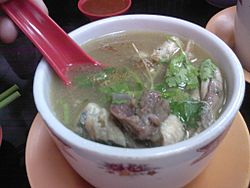Turtle soup facts for kids

Chinese turtle soup
|
|
| Type | Soup or stew |
|---|---|
| Place of origin | Various |
| Region or state | China, Malaysia, Taiwan, Japan, Singapore, Indonesia, and United States |
| Main ingredients | Turtle meat |
Turtle soup is a special kind of soup or stew. It is made using the meat from turtles. Different countries have their own ways of making this soup. Many people think it is a very fancy and rare dish, also known as a delicacy.
Contents
Where is Turtle Soup Eaten?
Turtle Soup in Asia
In countries like China and Singapore, turtle soup is a popular and special meal. People use the meat, skin, and even the inside parts of the turtle to make the soup.
Soft-shelled turtles are often used in Chinese cooking. People usually avoid eating hard-shelled turtles because of old stories and beliefs about them. However, the hard shells of some turtles are used to make a jelly-like dish called Guilinggao.
Turtle Soup in England
Turtle soup became very popular in England around the 1750s. It was a fancy dish, often served at big dinners. For example, it was always served at the London Lord Mayor's Day Banquet for many years.
People started bringing green sea turtles to England around 1728. The meat was said to taste like a mix of veal and lobster. At first, people would roast or boil the turtles. Later, they started making soup with them.
The demand for turtles was huge! Thousands of live turtles were shipped to Britain from places like Ascension Island and the West Indies. Because so many turtles were caught, their numbers dropped a lot. This made the soup very expensive. By 1861, it was known as the most costly soup you could serve.
Because real turtle soup was so expensive, people started making mock turtle soup. This soup was made from calf's head and tasted similar. It became popular on its own and was a cheaper choice.
Turtle Soup in the United States
In the United States, the common snapping turtle has often been used for turtle soup. This soup is sometimes called snapper turtle soup or just snapper soup. It is a thick, brown soup, a bit like a gravy.
In some areas, like the Chesapeake Bay, people used to catch diamondback terrapins for soup. In the San Francisco Bay, the Western pond turtle was also used for a smaller soup industry.
Even today, some restaurants in places like Minnesota still serve turtle dishes, including soup. This is often during Lent. The restaurant owners say that older customers, who have eaten turtle before, are usually the ones who order it. Younger people are less interested.
In some Creole communities, turtle soup is known as Caouane.
An interesting fact: The 27th U.S. president, William Howard Taft, even hired a special chef just to make turtle soup at the White House!
Is it Safe to Eat Turtles?
It is important to know that eating the meat of some sea turtles can be dangerous. It can cause a rare type of food poisoning. This kind of poisoning can be very serious. So, it's best to be careful and only eat food that is known to be safe.
See also
 In Spanish: Sopa de tortuga para niños
In Spanish: Sopa de tortuga para niños

